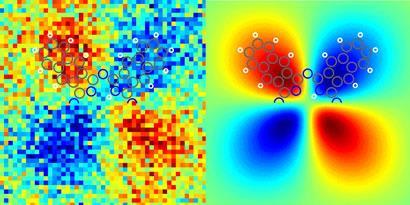Microscopists have mapped the distribution of charge across a single organic molecule for the first time
The distribution of charge across a single molecule has been imaged for the first time by Swiss scientists. It is hoped that this work may eventually lead to electronic devices consisting of organic molecules.
Fabian Mohn and his colleagues at IBM Research-Zurich in Switzerland are well known for their scanning probe microscopy research. So far, they have used atomic force microscopy (AFM) to ’view’ all the atoms in a molecule and measure the charge on single atoms, and have also used scanning tunnelling microscopy (STM) to ’see’ molecular orbitals. Now, they have used a third mode of the same microscope-Kelvin scanning probe microscopy (KSPM) - to image the charge distribution in a single organic molecule: naphthalocyanine.

The tip of the microscope is attached to a very small tuning fork, which oscillates at a set speed.The frequency of the oscillations changes slightly when the tip is brought close to a molecule, due to the influence of the forces between the two. In AFM, this so-called detuning is measured at hundreds of points across the molecule, and converted into an image. ’KSPM is very similar, you also measure the force but you measure it as a function of the voltage,’ explains Mohn. A voltage is applied between the tip and the conducting naphthalocyanine molecule. ’We look at which voltages the force minimises,’ at multiple points across the molecule. This tells them how strong the electric field is at that particular point on the molecule, and allows an image of charge distribution across the molecule to be created.

X-shaped naphthalocyanine was chosen as the demonstration molecule because it can switch between two different tautomers when a voltage is applied. The electrons shuffle around the molecule - and arms of the X change from positive to negative and vice versa - when the molecule is switched to its other configuration, Mohn explains. ’This allows us to see how the charge rearranges in the molecule when it switches, and to know immediately that we are not seeing an artefact.’
’They have developed a unique probe to look at the local charge in a molecule,’ says Franz Giessibl, an expert in AFM at the University of Regensburg in Germany. He describes the work as a ’very important benchmark’ towards the end goal of electronics using organic molecules. Organic electronics would be useful for light-harvesting technologies, electronics for inclusion in clothing and helping to drive down the cost of electronic devices, he says.
The next step for the IBM team is to probe the formation of covalent bonds between two molecules. ’First, you would look at the two molecules separately, and then you would form the bond. After the bond formation you look at how the charge has rearranged in the molecule,’ says Mohn.
Nina Notman
References
F Mohn et al, Nat. Nanotechnol., 2012, DOI: 10.1038/nnano.2012.20






No comments yet